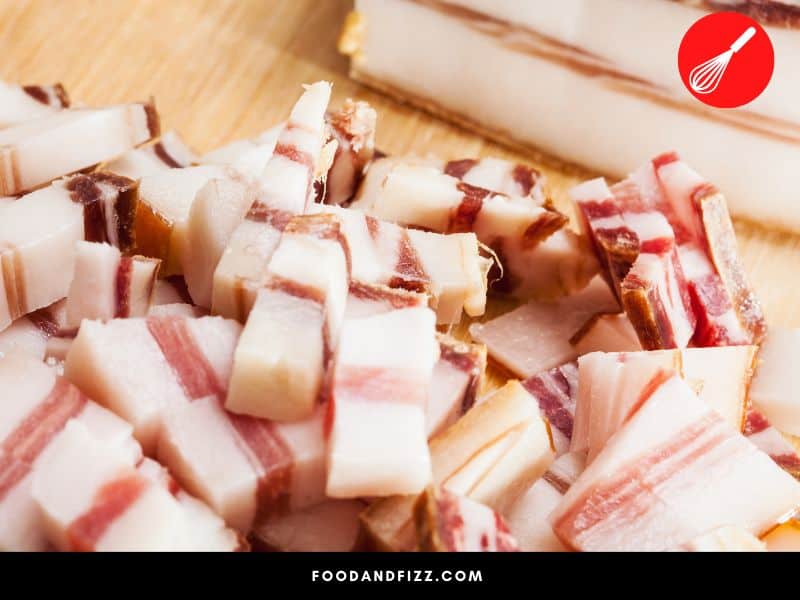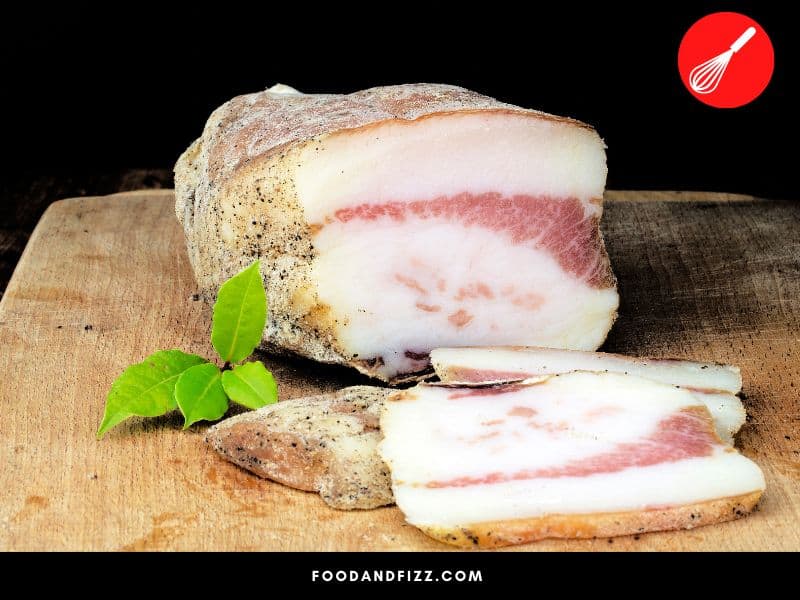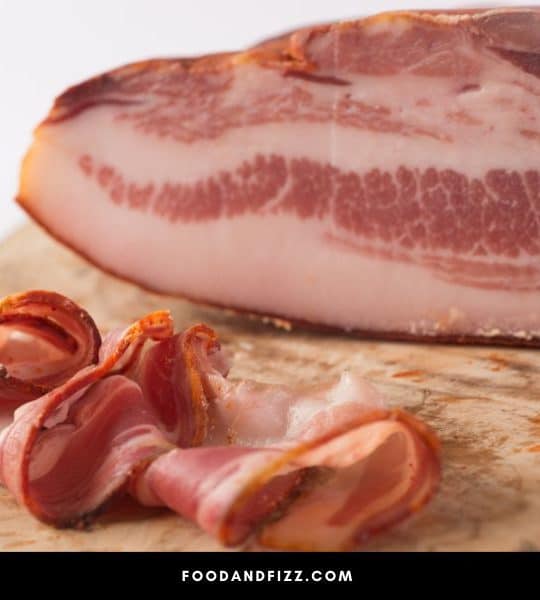Guanciale and pancetta are fatty, cured pork products often seen in Italian recipes. They add much flavor, texture, and depth to dishes and are essential in dishes like Carbonara, Amatriciana, or Gricia.
Most people think they are relatively the same, but is that the case?
How do these two pork products stack up against each other?
Guanciale vs Pancetta – What is The Difference?
Guanciale is a cured pork product that is made from pork cheeks while pancetta is a cured pork product made from the belly of the pig, much like bacon. Both are typically unsmoked and cured in salt, pepper, and a blend of herbs and spices, and then dried and aged. They both add flavor and depth to dishes like pasta and soups.

KEY DIFFERENCES GUANCIALE VS. PANCETTA
| GUANCIALE | PANCETTA | |
| PORK CUT | Cheeks or Jowl | Belly |
| ORIGIN | Lazio / Central Italy | All over the country |
| METHOD OF CURING | Dry cured | Dry cured or Brined |
| CURING TIME | Minimum of 60 days | 1-2 weeks, can be longer |
| CURING INGREDIENTS | Salt, pepper, herbs, garlic | Salt and pepper, some spices |
| FLAVOR & TEXTURE | Stronger taste and softer | Saltier |
| FAT CONTENT | More fat | Less Fat |
| PACKAGING | Sold whole | Sold in slices or cubes |
The Difference Between Guanciale and Pancetta
Guanciale and pancetta are both used extensively in Italian cooking. They are both cured, fatty pork products that impart flavor and texture to a dish.
Many people have heard of pancetta because it closely resembles what we know as bacon. Guanciale, though, is lesser known but is touted by many as superior in terms of what it can do for dishes.
How do they differ from each other? Let’s compare them below.
1. Pork Cut
Both guanciale and pancetta are fatty pork products but are made from different parts of the pig. Pancetta is made from pork belly, while guanciale is made from pork cheeks or pork jowl.

2. Origin
Pancetta is typically enjoyed all over Italy, but guanciale is a specialty of central Italy, specifically in the Lazio region. It is so well loved in that region that most of their famous pastas include guanciale.
3. Method of Curing
Guanciale is dry cured with salt and spices like black pepper, rosemary, and sage, and is aged and matured for a minimum of 60 days.
Pancetta, on the other hand, can be dry-cured or wet-cured in brine, usually only with salt, but sometimes with other spices too. The curing process can be done in as little as two to three weeks, although it can be cured for longer depending on the producer.
In general, guanciale and pancetta have shorter curing periods compared to other types of cured meat, which means they retain a good amount of moisture in them which makes them so lovely to use in dishes.
4. Ingredients and Curing Agents Used
Pancetta is normally cured only with salt and pepper, although sometimes spices are added, depending on the manufacturer.
Guanciale, on the other hand, is typically cured with salt, pepper and other herbs and spices like garlic, sage and rosemary, depending on the preference of the region.
5. Flavor, Taste, and Texture
Guanciale has a stronger flavor than pancetta but it has a somewhat softer texture. Pancetta is saltier than guanciale.
The fat content in guanciale though is higher than in pancetta, which is why some believe it does a much better job in adding depth and character to dishes.
6. How They Are Packaged and Prepared
Both guanciale and pancetta are cured pork products that are traditionally unsmoked, although smoked varieties do exist.
Guanciale is typically sold whole, while pancetta is sold in slices and cubes. While they are both cured products, popular uses for both types of meat require them to be cooked first before consumption.
What is Guanciale?
Guanciale is lesser-known than pancetta, but many believe that it imparts a better flavor and depth to dishes compared to pancetta.
So why is guanciale so loved?
Guanciale is a dry cured pork product that is made from pork jowl or pig’s cheeks. This is the part between the neck and the jaw, just under the cheeks of the pig. The Italian word “guancia”, which means “cheeks”, is where the name is derived from.
It has been around for centuries and is traditionally a staple meal of farm workers who would typically have it over bread, with a little pecorino cheese and some wine.
It looks similar to pancetta or bacon, but it is fattier and more delicate. It also has a stronger flavor than pancetta or bacon.
In Italy, it is a must in pasta carbonara, amatriciana, or pasta gricia. Besides pasta, it can be rendered and sautéed with vegetables, meat, or fish for added texture and flavor.
Guanciale is dry cured with salt and various spices, left to dry, and aged for a minimum of 60 days. The longer guanciale is aged, the better the flavor becomes and the more robust its taste is when added to dishes.
It can be consumed as is, or over bread, but it truly shines when it is added to sauces and stews, and soups.

How Is Guanciale Made?
Guanciale is typically made in the following way:
1. Salting and Seasoning
The pork jowls are salted for a few days and then spices and seasonings are added by the butcher.
The specific blend of spices varies depending on the butcher and the region, and most of the time it is a closely guarded secret of a traditional recipe. But spices like black pepper, rosemary, thyme, and sage are often used.
2. Curing
The guanciale is hung and cured in a relatively colder environment to allow the salt to work its way into the meat. The salt is what also protects the meat from bacteria and pathogens that may spoil the meat.
3. Drying and Maturing
The drying phase raises the internal temperature of the guanciale to jumpstart some enzymatic processes like the production of lactic acid, but after this phase, it is brought down again to temperatures of 50- 57 °F and allowed to age and mature in a temperature-controlled and humidity-controlled environment for at least two months.
It is said that the longer it is aged, the more developed and desirable the flavor becomes, due to chemical reactions that take place that breaks down the amino acids and fatty acids in the meat.
This longer aging process is what gives it character and depth, and the strong pork flavor.
Is Guanciale The Same As Jowl Bacon?
Jowl bacon or hog jowl is bacon that is made from pork jowl or pig’s cheeks. It is an important staple in U.S. Southern cuisine.
Guanciale is similar to jowl bacon in that they are both made from pork jowl, however, they are different in that guanciale is typically unsmoked, while jowl bacon is smoked and typically prepared and used in much the same way as regular pork belly bacon.
Guanciale is also typically cured and aged for a longer period of time, and the spices used to cure guanciale is different from jowl bacon.
What Is Pancetta?
Pancetta is a cured pork product that is made from the belly or underside of the pig.
It is often called “Italian bacon”, and while it shares similarities with its American cousin, it also has marked differences. While American bacon is smoked, pancetta is typically unsmoked
There are two basic types of pancetta:
1. Pancetta Tesa
“Flat” or slabbed pancetta, similar in appearance to typical bacon. It is cured and dried in its natural shape.
2. Pancetta Arrotolata
“rolled” pancetta or pancetta that has been tightly rolled and trussed into a log, sometimes stuffed into a casing to hold its shape. This is perhaps the more popular form of pancetta.
It is typically leaner than pancetta tesa. A kind of pancetta arrotolata, pancetta coppata, is when lean cured pork belly is wrapped around another kind of dry-cured meat, called coppa or capicola, which is similar to prosciutto.
Pancetta is rarely smoked but if it is, it is called pancetta affumicata. Despite the smoking, it still has quite a different flavor from American smoked bacon.

How Is Pancetta Made?
Pancetta is made in the following way:
1. Salting and Curing
The pork belly is salted and left to cure for about a week to 10 days.
2. Washing and Seasoning
After this period, the salt is washed from the pork belly, sometimes with white wine, and then the seasoned with herbs and spices like pepper, fennel, coriander, and juniper berries.
Seasonings may change depending on the producer. This is what is called “concia”.
3. Rolling
If making pancetta tesa, the concia or spice blend is rubbed all over the exposed skin before they are hung to dry in a temperature-controlled and humidity-controlled room.
If making pancetta arrotolata, the spices or concia end up inside the pork belly when it is tightly rolled into a log. It is then placed inside casings and then tied and trussed before hanging to dry.
4. Drying and Maturing
The pancetta is left to dry and hang in a cool, dry place for several weeks, sometimes months.
The procedure may change depending on the producer. Some season right away with the initial salting and re-season only with black pepper, while some add the spice blends after the initial salt cure. It would just ultimately depend on the producer and the home cook.
No matter how you make your pancetta, the drying and maturing process is crucial in the development of its flavor.
Is Pancetta The Same As Bacon?
Pancetta and bacon are both made from pork belly, but while bacon is typically wet-cured and brined with salt, sugar, seasonings and sometimes nitrates and nitrites, pancetta is traditionally dry-cured and matured, with mostly just salt and black pepper.
Although herbs and spices are also sometimes used, depending on the producer.
Bacon is also smoked while pancetta is typically unsmoked. Bacon is usually in strips or slabs, but pancetta can be in strip or slab form, or circular in shape.
In some recipes, they might work as good substitutes for each other but they also have distinct flavor profiles.
Is Pancetta The Same As Prosciutto?
Pancetta is not the same as prosciutto. Prosciutto is a dry cured meat made from pork legs, which goes through a longer curing and aging period that can last from several months to years.
Pancetta typically is only cured from weeks to months and is considered a fresh cured meat.
While pancetta can be consumed raw, it typically isn’t, at least outside of Italy. It is normally added to dishes and cooked. Prosciutto is consumed raw to better appreciate the flavors from the long curing and aging process.
Conclusion to Guanciale vs Pancetta
Guanciale and pancetta are both cured pork products that impart a depth of flavor to dishes like pasta, soups, and stews.
Pancetta is the more widely known among the two, but most believe that guanciale is more superior in terms of flavor as it is normally aged for longer and typically has more fat.
However, if you cannot find guanciale, pancetta may work as a workable substitute in many recipes.

Frequently Asked Questions to Guanciale Vs Pancetta
Should I Use Guanciale or Pancetta for Carbonara?
Either may be used but guanciale is more traditionally used in carbonara, and most believe it lends a superior flavor to the dish compared to pancetta.
What Can I Substitute for Guanciale?
Guanciale may be harder to find outside of Italy, so in case you need a substitute, pancetta may often work in most recipes. Unsmoked bacon may also be used.
Is Pancetta the Same as Prosciutto?
Pancetta is not the same thing as prosciutto. Prosciutto is made from pork hind legs or thighs while pancetta is made with the pig’s underside or belly. Prosciutto is also aged and matured for a longer time than pancetta and is typically consumed raw.

